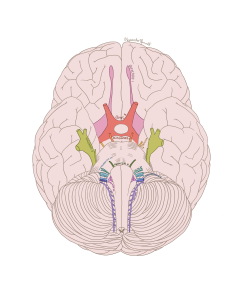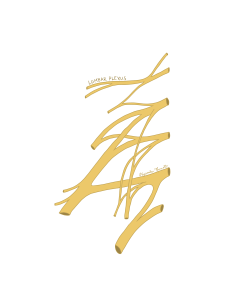47
What is the peripheral nervous system?
Departing from the central structures of the nervous system, we end up at the peripheral nervous system. This vast network of nerves extends beyond the brain and spinal cord, serving as the vital communication link between the central nervous system (CNS) and the rest of the body. It is through the peripheral nervous system (PNS) that the brain’s intentions become actions, and the body’s sensations become conscious experiences. Comprising cranial nerves, spinal nerves, plexuses, the PNS is functionally divided into the somatic and autonomic nervous systems—discussed in the prior subchapter. Though less protected than its central counterpart, the PNS plays an equally essential role in maintaining the body’s connectivity and responsiveness.
Cranial nerves:
Humans rely on their senses each and everyday to navigate the world whether it is through vision, smell, tasting, balancing or sensing. Each of these key functions is facilitated in part by 12 pairs of nerves originating in the brain stem, known as the cranial nerves. These 12 pairs of nerves can have sensory, motor or a mix of both functions. They are also commonly referred to numerically, based on their position. Cranial nerve I is the most superior and cranial nerve XII is the most inferior.

Figure 101 The cranial nerves; inferior view
| Cranial nerve | Name | Function | Composition | Point of Origin |
| I | Olfactory nerve | Olfaction (smell) | Sensory only | Frontal lobe |
| II | Optic nerve | Vision | Sensory only | Frontal lobe |
| III | Oculomotor nerve | Motor control of eye muscles which move eye | Motor only | Midbrain |
| IV | Trochlear nerve | Motor control of eye muscles which move eye in downward inward directions | Motor only | Midbrain |
| V | Trigeminal nerve | Sensory from face and mouth; motor to muscles of mastication (chewing) | Motor and Sensory | Pons |
| VI | Abducens nerve | Motor control of eye muscles abducting the eye | Motor only | Pons |
| VII | Facial nerve | Motor control and sensation of facial muscles, and stimulates salivation | Motor and Sensory | Pons |
| VIII | Vestibulocochlear nerve | Audition (hearing), perception and balance | Sensory only | Pons |
| IX | Glossopharyngeal nerve | Sensation to posterior third of tongue and provides sensation for taste | Motor and Sensory | Medulla |
| X | Vagus nerve | Controls autonomic nervous function of the heart, lungs, and digestive tract, and provides sensory input to the throat | Motor and Sensory | Medulla |
| XI | Accessory nerve | Motor innervation of upper trapezius fibres and other neck muscles | Motor only | Medulla |
| XII | Hypoglossal nerve | Motor control of tongue and swallowing | Motor only | Medulla |
What is a plexus?
Think of a massive highway interchange, where cars can change routes and ensure they end up at the right place. A plexus is another word for an interconnected network of nerves that come together and then branch out to the various parts of the body, acting like a neurological traffic hub. These networks are formed by nerves that join together. The primary purpose of a plexus is to distribute nerve signals efficiently to multiple areas, allowing for complex coordination of movement and sensation.

Figure 102 The lumbar plexus; anterior view
When nerves leave the spinal cord, the plexus acts as a network that allows nerve fibres from different spinal nerves to mix and redistribute. This allows for ‘backup’ pathways. If one nerve is damaged, others in the plexus can still help supply signals to the affected region. This redundancy is especially helpful in areas that need precise control or sensation.
Take the brachial plexus, for example. It is made from nerve roots C5 to T1 and controls arm movement, providing sensation to the shoulder, arm, forearm, and hand. From the spinal cord, the nerves come together, split, and recombine several times as they travel down the arm.
Types of major plexuses:
- Cervical Plexus: Serves the neck and shoulder region.
- Brachial Plexus: Controls the shoulder, arm, and hand.
- Lumbar Plexus: Supplies nerves to the lower abdomen and thighs.
- Sacral Plexus: Extends to the legs and feet.

